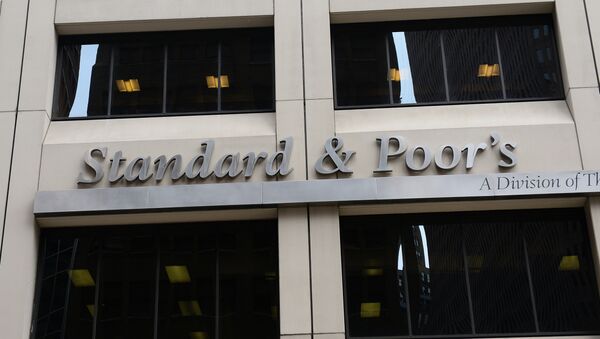WASHINGTON (Sputnik) — Standard & Poor’s (S&P), one of the 'big three' US-based credit rating agencies, has affirmed Russia’s BB+/BBB- sovereign debt rating, placing it on the borderline between "junk" and investment-grade status.
"We are affirming our 'BB+/B' foreign currency and 'BBB-/A-3' local currency sovereign credit ratings," the release on the company’s website stated. "At the same time, we have revised our transfer and convertibility (T&C) assessment on Russia to 'BBB-' from 'BB+'."
Standard & Poor’s is among the world's leading credit rating agencies; it provides a wide range of information in the sphere of financial markets. Sovereign debt ratings such as Russia's reflect the risk level of the investment climate of a country. All other debt issued within a country, whether it's by a public entity such as a municipality or by a privately-owned company, is considered more risky than the sovereign debt rating. Furthermore, institutional investors such as managers of pension funds and mutual funds usually, as a matter of policy, avoid speculative debt.
"The positive outlook indicates that we may raise our ratings on Russia if the recovery in economic trend growth continues or if preserved financial stability translates into stronger bank lending activities," the agency explained.
Russian Finance Minister Anton Siluanov noted that Russia's poor rating hasn't prevented investors from buying Russian government bonds.
"Rating agencies are still being conservative about assessing our economy. But foreign investors have been actively purchasing our bonds and currency despite their non-investment ratings and geopolitical ruckus," he told reporters.
Russia's top financier explained that this trend was the result of the government’s concise budget policy, which makes the Russian economy predictable. In addition, newly-adopted budget rules have decreased the dependence of the economy and the national currency on oil prices.
Standard & Poor’s expects the country’s economic recovery to continue through 2020, with GDP growth of 1.8 percent in 2017 and an average increase of 1.7 percent in 2017-2020, whereas the Russian finance minister expressed confidence that the gap between credit ratings and real-life investor assessments would narrow as the Russian economy continued to grow.


